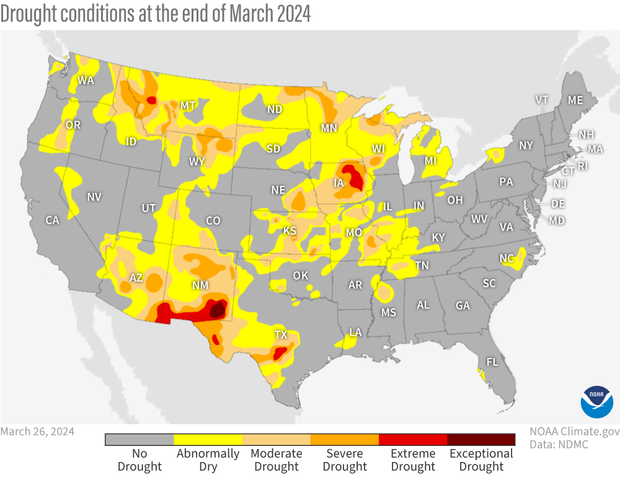by Ryan Hanrahan, University of Illinois’ FarmDoc project
The National Oceanic and Atmospheric Administration reported Tuesday that “after a wet winter and early spring across much of the country, drought across the continuous United States had decreased to around 18% by the end of March, down from 20% at the end of February, and from about 36% at the beginning of winter.”
“This is the least amount of drought across the country since May 2020,” NOAA said. “Additionally, the percent of the country in the two most intense categories (D3-D4, representing extreme and exceptional drought) was only about 1% at the end of March, also the lowest amount since May 2020.”
Where the Worst Drought Conditions Still Exist
Some of the most severe drought conditions in the United States currently exist in New Mexico, where 3.51% of the state — mostly in the Southwest corner — is experiencing exceptional drought and 16.72% of the state is experiencing at least extreme drought.
Extreme drought also exists in Iowa, with 11.09% of the state currently experiencing extreme drought conditions. That percent of extreme drought in Iowa is, however, “down from 35% of the state at the start of 2024,” according to reporting from We Are Iowa’s Brandon Lawrence.
“Recent soaking rainfall is the cause,” Lawrence reported. “From March 1 to March 26, Des Moines received 2.38″ of rain, which is above average for that timeframe. Since Jan. 1, Des Moines has seen about a half inch of precipitation more than normal. Other parts of Iowa benefited from healthy rains as well, especially over the western half of the state.”
Drought Decreases Come Before Spring Planting
Progressive Farmer’s John Baranick reported Tuesday that this spring, an “active storm track has continued and during the last week, we have started to see some real gains in the subsoil moisture profiles according to a lot of measurements.”
“The barrage of storm systems is more likely to fill up some of the dry soils out there that still exist, and set up the early growth of the coming crop with good soil moisture as we head to a potential hot and dry summer thanks to that building La Nina in the Pacific,” Baranick wrote.
“While there are concerns about planting being delayed this spring, the concerns are probably a bit unfounded,” Baranick reported. “The active pattern may lead to some precipitation delays, but significant setbacks due to waterlogged soils are unlikely to occur.”
Drought Outlook
NOAA reported Tuesday that “the drought outlook for April also has less coverage, with a mix of drought persistence and improvement and no regions predicted to develop drought.”
“With equal chances for above-, below-, or near-average precipitation forecast for the northern part of the nation from the Great Lakes westward, drought currently in areas across the northern Rockies and western Great Lakes is expected to persist,” NOAA said. “The Southwest is more of a mixed bag, with those regions favored to be wetter than average in Arizona and central Texas likely to see drought improvement (or even removal), but with the regions in New Mexico and West Texas that are in drought expected to persist.”
“Finally, drought is expected to improve (with some removal) across the Central Plains and western Corn Belt, with wetter-than-normal conditions favored in the monthly outlook (as well as in CPC’s Week-2 outlook), certainly good news for agricultural concerns in this region,” according to NOAA.



